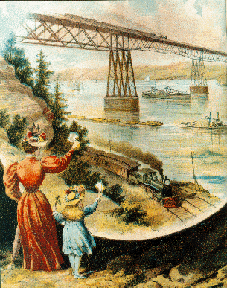 The University of Chicago Magazine June 1995
The University of Chicago Magazine June 1995
 "On the broad surface of the river they could see steamboats…and along the shore railway tracks extended on which trains were rushing at full speed." -- Railroad Story Book (New York: McLoughlin Brothers, 1907).
"On the broad surface of the river they could see steamboats…and along the shore railway tracks extended on which trains were rushing at full speed." -- Railroad Story Book (New York: McLoughlin Brothers, 1907).
SMILING AIRPLANES, faithful steam shovels, plucky trolleys, and even pluckier locomotives: Somewhere in his or her past, every Baby Boomer has a dog-eared book in which the hero or heroine is a machine with a heart of gold.
"The pioneer, and still champion," of this genre, according to Neil Harris, "was the 1930 classic The Little Engine That Could, the story of a small, diffident, doubting engine who masters an emergency and carries a trainload of toys to children just in time for Christmas."
If that plot sounds all too familiar today, Harris -- the Preston and Sterling Morton professor in history -- points out that "the notion of taking a locomotive, endowing it with emotions, personality, and intelligence, and giving it, moreover, a set of human features...would have seemed odd" as late as the 1920s.
The Little Engine That Could couldn't have happened without the modern transportation revolution, launched with the whistle-blowing arrival of steamboats and steam engines in the first years of the 19th century. As the new machines helped tranform society, they also sped into the pages of books for both adults and children
Click here to continue reading "Moving Pictures"